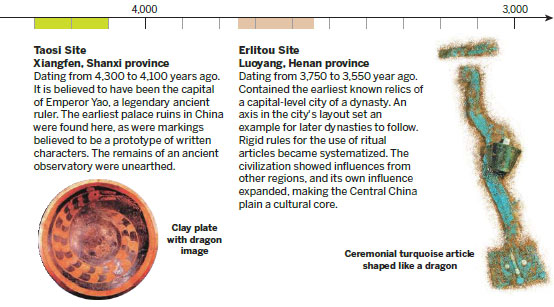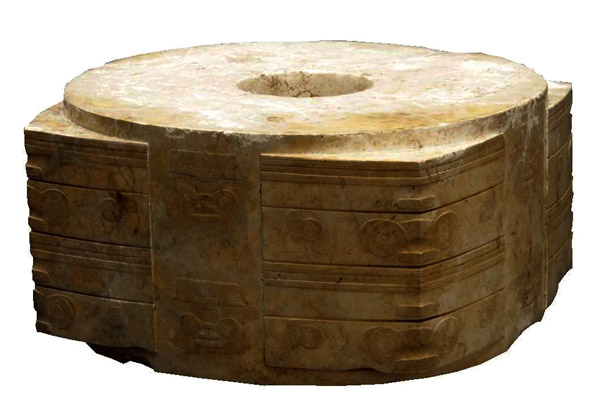Physical evidence found for 5,000 years of civilization
It is often said that Chinese civilization extends back 5,000 years. Now, after 15 years of intense research as part of a nationwide project to explore the origins of that civilization, archaeologists are able to back up that statement with solid physical evidence.
It is often said that Chinese civilization extends back 5,000 years. Now, after 15 years of intense research as part of a nationwide project to explore the origins of that civilization, archaeologists are able to back up that statement with solid physical evidence.
The results were disclosed at a news conference on Monday at the State Council Information Office of China.

The project has proved with physical evidence that Chinese civilization exhibited a multifaceted unity, said Guan Qiang, deputy director of the State Administration of Cultural Heritage. "It was inclusive, and its succession has never stopped."
Previously, some overseas scholars expressed doubts about the length of Chinese civilization due "to a lack of physical evidence."
After several years' preparation, the project was launched by the Ministry of Science and Technology and the heritage administration in 2004.
Nearly 70 research institutions and universities have participated in the program, which is led by the Chinese Academy of Social Sciences' Institute of Archaeology and Peking University's School of Archaeology and Museology.
Over 900 academic papers have been published on the project, including nearly 400 released in foreign languages or in overseas journals, Guan said.
"We have done large archaeological investigations in several key, capital city-level sites from 5,500 to 3,500 years ago," said Wang Wei, a leader of the program from the CASS.
New discoveries kept appearing with the help of new research technologies.


For example, at the Liangzhu Site in Hangzhou, Zhejiang province, which dates from 5,300 to 4,500 years ago, archaeologists unearthed a huge dam 3.5 kilometers long and more than 10 meters thick. Ruins of the city cover 3 million square meters, and the city's walls are 40 to 60 meters thick. The discovery was made possible with remote sensing technology.
"In the city center, we found a terrace that is 630 meters by 450 meters," he said. "Some of the foundations are as large as 900 square meters."
He estimated that the entire city would have taken 10,000 people a decade or longer to build.
"It hardly would have been possible for a tribe or a league of tribes to mobilize so many people," Wang said. "That indicated a time of early-stage states with wide influence."
Division of labor, hierarchical social classes and inequality in wealth were also observed when studying the Taosi Site (from 4,300 to 4,100 years ago) in Xiangfen county, Shanxi province, and several other key sites of "huge city ruins," he said.
The relics are from what is believed to have been the capital of Emperor Yao, a legendary ancient ruler. Some markings were discovered that are believed to be a prototype of written characters, but they appear to have been used exclusively within a small group of ruling elites.
"Around 5,000 years ago, some regions along the Yangtze River, the Yellow River and the western bank of Liaohe River (in Northeast China) stepped into the age of civilization," Wang said. Those ancient states, he said, "controlled certain territory, but had economic, political and cultural connections with each other."

During the time of the Erlitou Site (3,750 to 3,550 years ago), in Luoyang, Henan province, China entered what is often called the age of dynasties, Wang said.
"Erlitou marked the time when the Central China plain began to widely influence the surrounding areas," he said. "It created a foundation for a united country with multiethnic groups."
Speaking of how to define "civilization," Zhao Hui, a professor at Peking University who is in charge of the project, said traditional criteria in Western academia, which emphasize the appearance of written characters and metallurgy, have not strictly been used in this project.
Liangzhu and several other early civilizations in China, however, are known for their highly developed techniques in making jade articles.
"Some characters of human development are common," Zhao said. "The difference also shows there are some unique characters in early Chinese civilization."
He said Chinese civilization also absorbed influences from other civilizations. Archaeological discoveries show wheat cultivation, breeding of cattle and sheep, and bronze-making technology in China originated in Western and Central Asia and were later adopted and acquired local characteristics.
People in South China were the first to begin growing rice about 10,000 years ago and millet in North China about 8,000 years ago, and thus also benefited the rest of world.
"Through the project, we fill a void for a pivotal period in Chinese history," Zhao said. "And it's also a big contribution to the world because Chinese civilization is a crucial segment in human history."
Shen Jiliang, an official with the Ministry of Education in charge of textbooks, said the new academic achievements will be soon included in school syllabuses.
The 4,000-year-old Shimao Site, city ruins found in Shenmu, Shaanxi province, had never appeared in any ancient historical record before being unearthed in recent years. The relics show a strong military presence considered to have close connections with Taosi, and they are now treated as one important origin of Chinese civilization.
Shen said such new discoveries will be added to high school textbooks.
"History education concerns our nurturing of national pride and cultural confidence," he said.